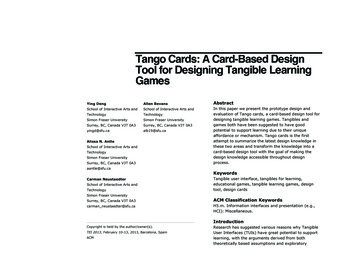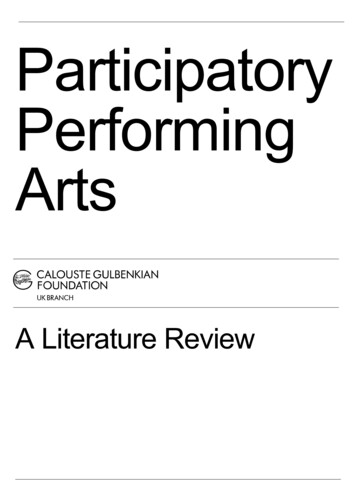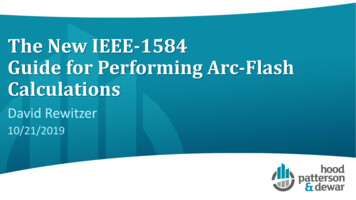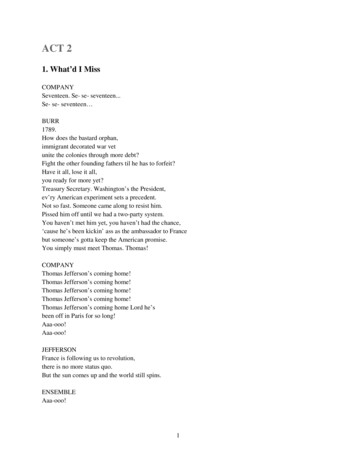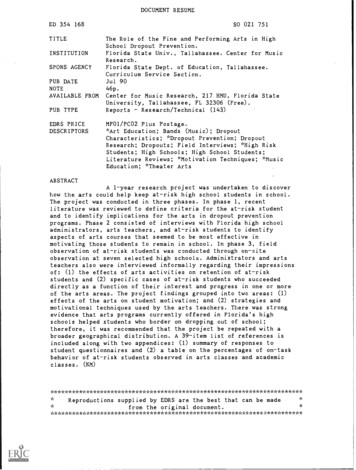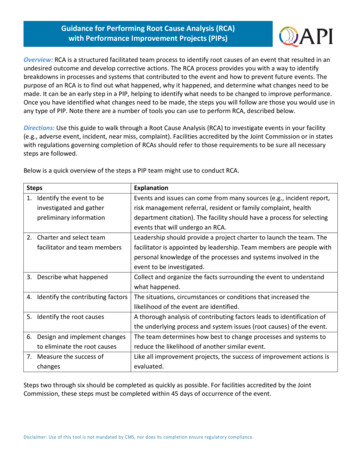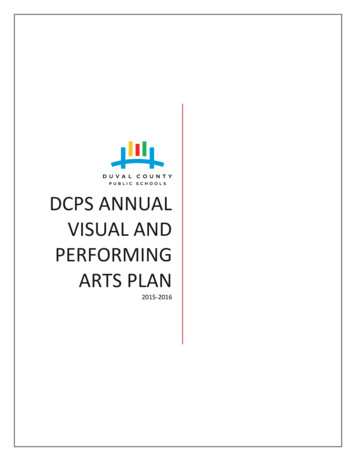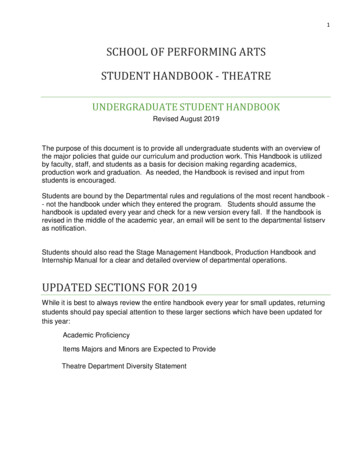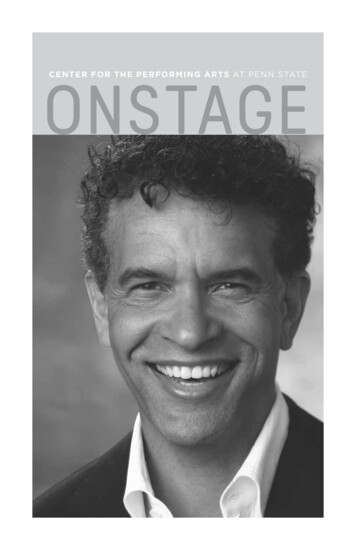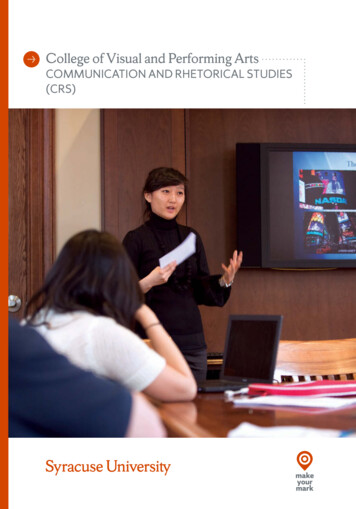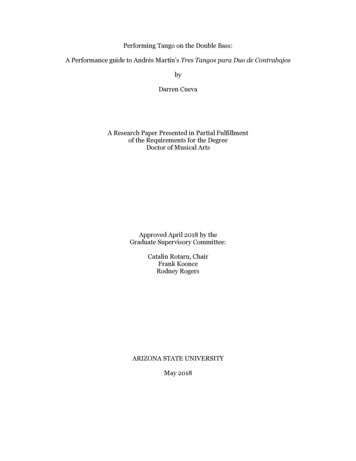
Transcription
Performing Tango on the Double Bass:A Performance guide to Andrés Martín’s Tres Tangos para Duo de ContrabajosbyDarren CuevaA Research Paper Presented in Partial Fulfillmentof the Requirements for the DegreeDoctor of Musical ArtsApproved April 2018 by theGraduate Supervisory Committee:Catalin Rotaru, ChairFrank KoonceRodney RogersARIZONA STATE UNIVERSITYMay 2018
!ABSTRACTTres Tangos para Duo de Contrabajos (Three Tangos for Double Bass Duet) is a threemovement set written by Andrés Martín and commissioned by Darren Cueva specificallyfor this document and accompanying performance project. This piece blends tango withWestern art music in a style often referred to as “nuevo tango” (new tango) which waspopularized by Astor Piazzolla. This research paper will serve as a performance aid forthose wishing to present tango idioms on the double bass in addition to a more detailedguide to performing Tres Tangos by Martín.To give context to performers, this survey begins with a brief history of the tangoand the life and stylistic developments of Astor Piazzolla. Various music and dance stylesthat contributed to early tango include, milonga, habanera, and tango andalúz. Theresulting tango was popularized as a music and dance style in the early twentiethcentury. Astor Piazzolla brought the tango to the concert hall after studying compositionwith acclaimed professor Nadia Boulanger. His new tango style merged traditionaltango, classical composition, and jazz music, which he was exposed to after his familymoved from Argentina to New York.Tres Tangos was modeled after the style of Piazzolla. Characteristic articulationand improvised techniques are a fundamental aspect of the tango sound; a successfulperformance will depend on the musician’s ability to create these sounds. A detaileddescription of the most common elements is provided as well as suggestions for creatingthem on the double bass. Finally, I have compiled a specific performance guide for TresTangos. This guide includes rhythmic, articulation, fingering, and notationalconsiderations, to assist in the performance of this piece.!i!
!ACKNOWLEDGMENTSI would like to first and foremost thank my family. My wonderful partner, Stacy,has been by my side through the ups and the downs and has been a limitless source ofstrength and inspiration to me. My parents have not always understood my musicalambitions but they have always supported me and encouraged me to excel. I have beenblessed to have brothers, in-laws, and extended family to support me with their love andkindness. Thank you all.I would like to give a special thanks to the members of my committee. CatalinRotaru has truly shaped me into the musician that I am today. He has guided me formany years and it is difficult to express in words all that he has done for me. RodneyRogers not only provided me with excellent instruction and feedback during my time atASU but has also helped me grow as a teacher and lecturer. Frank Koonce has also beena great mentor, encouraging me to explore new aspects of my instrument andperformance mediums.Finally, thank you to my previous teachers and all of my colleagues throughoutthe years. Gunnar Biggs was the first to introduce me to the bass and he gave mewonderful instruction that lit my enthusiasm for music. Eric Hansen saw something inme when there was not much to see and gave me the best possible preparation forgraduate school. All of my friends and colleagues from bass studios, festivals, andensembles have inspired me and brought me to the next level. I would like to especiallythank my dear friend Andrés Martín for writing this amazing piece.!ii!
!TABLE OF CONTENTSPageLIST OF FIGURES ivCHAPTER1INTRODUCTION .12BACKGROUND .33ASTOR PIAZZOLLA: LIFE AND STYLE .114ANDRÉS MARTÍN: ABOUT THE COMPOSER .165PERFROMING TANGO STYLE ON THE DOUBLE BASS .186PROGRAM NOTES: TRES TANGOS PARA DUO DE CONTRABAJOS .267PERFORMANCE GUIDE: TRES TANGOS PARA DUO DE CONTRABAJOS .29Rhythmic Considerations .29Articulation Considerations .31Fingering Considerations .37Practical Considerations 43BIBLIOGRAPHY 47!iii!
!LIST OF FIGURESFIGUREPage1Habanera and Sincopa Rhythms in Notation . 62Chart of Rhythmic Similarities Among Several Dance Genres 93Rhythmic Component of Chicharra in Notation .204a Tres Tangos para Duo de Contrabajos, mov. III, “La feria de San Telmo,”m. 12 304b Tres Tangos para Duo de Contrabajos, mov. I, “Microcentro,” m. 10 .305Tres Tangos para Duo de Contrabajos, mov. I, “Microcentro,” m. 52 .316Tres Tangos para Duo de Contrabajos, mov. I, “Microcentro,” m. 5 327a Tres Tangos para Duo de Contrabajos, mov. III, “La feria de San Telmo,”m. 26 . 347b Tres Tangos para Duo de Contrabajos, mov. III, “La feria de San Telmo,”mm. 69-71 .348Tres Tangos para Duo de Contrabajos, mov. I, “Microcentro,” mm. 51-52 .359Tres Tangos para Duo de Contrabajos, mov. II, “Balvanera,” mm. 58-59 3510 Tres Tangos para Duo de Contrabajos, mov. III, “La feria de San Telmo,”mm. 58-59 .3611 Tres Tangos para Duo de Contrabajos, mov. III, “La feria de San Telmo,”m. 18 .3712 Tres Tangos para Duo de Contrabajos, mov. I, “Microcentro,” m. 7 3813 Tres Tangos para Duo de Contrabajos, mov. I, “Microcentro,” m. 40 .3914 Tres Tangos para Duo de Contrabajos, mov. I, “Microcentro,” m. 78 .3915 Tres Tangos para Duo de Contrabajos, mov. I, “Microcentro,” m. 59 .4016 Tres Tangos para Duo de Contrabajos, mov. III, “La feria de San Telmo,”m. 139 42!iv!
!CHAPTER 1INTRODUCTIONTres Tangos para Duo de Contrabajos (Three Tangos for Double Bass Duet) is athree-movement work by Andrés Martín commissioned by Darren Cueva specifically forthe present research project. This work was premiered by Darren Cueva and AndrésMartín on March 31, 2018, at Arizona State University. It was important to me that thispiece be collaborative and written specifically for the double bass. During the course ofearning a college degree in classical music performance, it is normally required forstudents to participate in the performance of chamber music. Bass players, however, areoften excluded from these opportunities. The reality is that most chamber works werenot composed with a double bass in the instrumentation, and the ones that do includebass are infrequently programmed. However, I firmly believe that the skills developedwhile collaborating in small ensembles are invaluable to becoming a successfulperformer. While performing with pianists in recitals is a good experience, working withsimilar instrument types, such as strings, winds, and other mixed ensembles, requiresmuch more careful attention to blend tone colors, articulations, and a variety of othermusical elements.Since bass players have limited opportunities to participate in standard chamberrepertoire, there has been a surge of interest in chamber music for bass ensemblesbeginning in the twentieth century. This piece adds to that repertoire and will hopefullybecome a staple of collaborative bass music for future generations. With this piece,Martín has created an opportunity for bassists to play together and learn these importantmusical skills. The piece can be performed as a three-movement set, but each movementcould also be performed as a stand-alone piece, easily added to a chamber music concertor double bass recital. The work may seem challenging and will indeed require a!1
!significant amount of work for most bassists. The following performance guide isintended to help musicians navigate the more complicated aspects of this music. Beforetechnical aspects required for a successful performance are addressed, it is firstimportant to know about the evolution and development of the tango. Thisunderstanding will contextualize the history of the style and will contribute to aperformance, which might otherwise sound lacking.The following survey was designed to help double bass players understand tangomusic and effectively perform in the tango style. The document begins with a briefbackground of tango music to help performers contextualize the tradition. This isfollowed by historical information about Astor Piazzolla and the new tango style that hepioneered. Following these historical sections, there is a chapter on common tangotechniques with performance suggestions specific to double bass players. The finalsections include program notes and a performance guide for the commissioned work,Tres Tangos para Duo de Contrabajos.!2
!CHAPTER 2BACKGROUNDA precise history of the tango is unknown. Even a preliminary survey of theavailable literature yields inexact dates of origin and a variety of music and dance stylesthat could have contributed to its creation. I-Ching Tsai cites four dance styles thatcontributed to the tango: Candombe, Milonga, Habanera, and Tango Andalúz.1Candombe: (not to be confused with the Brazilian Camdomblé) A genre thatcame to Argentina from West Africa via Uruguay some time near the turn of thenineteenth century. This style consisted purely of rhythmic sounds with no melodiccomponent. During the Carnival season2 it was common for comparsas, groups thatwould parade through the streets, to gather and represent various social identities.3 Onesuch group, the Negro Argentinos, followed others in opting for an American identityover an African one; however, this group saw African instruments as too important tosimply abandon.4 The result was a combination of drums and rhythms of candombe tobe combined with melodies, harmonies, and instruments from Europe. The combinationresulted in a new kind of music they called “tango.”5 Journalist Vicente Rossi !!!!!!!!!!!!!!!1I-Ching Tsai, “The Evolution of the Tango and Astor Piazzolla’s Tango Nuevo” (DMAdiss., Claremont Graduate University, 2005): 2-6.2Carnival is a Christian festive season especially prominent in Western Christiantraditions. The season takes place before Lent (a period of fasting beginning forty-sixdays before Easter) and in many Latin American countries the festivities include paradesand public celebrations.George Reid Andrews, “Remembering Africa: Comparsas and Candombe, 1870-1950,”in Blackness in the White Nation: A History of Afro-Uruguay (Chappel Hill, NC: TheUniversity of North Carolina Press, 2010): 51.34Ibid., 51-52.!5!Ibid., 52.3
!the similarities of candombe and early tango, even going as far as to call early tango ofthe 1860s “Creolized candombe.”6Milonga: A vocal genre accompanied by guitar in 2/4 time, used by the gauchos,or native cowboys. In Argentina, milonga has since grown into a tradition very muchassociated with dance and with tango. So entangled are the milonga and tango traditionsin Argentina that Ana Cara describes tango as being “closely related to (and sometimessynonymous with) the milonga cultural complex . . . The term ‘milonga’ refers not only totango dance halls in Buenos Aires but also to the tango dance venues that haveproliferated worldwide with increased popularity of tango dancing.”7 Cara includes thefollowing quote from Alfredito, a famous milonguero as further evidence: “El tango no seentiende sin la milonga” (tango can’t be understood without the milonga).8Habanera: “A Cuban style that grew out of a stylization of the Spanishcontradanza, which was itself a stylization of the English Country Dance.” 9 Behaguéargues that the habanera rhythmic formula is the rhythmic base for most Latin dancemusic including the Argentine milonga and tango.10Tango Andalúz: A popular danceable song type from late-eighteenth-centurySpain that included rhythmic elements from African traditions. Slaves accompanying !!!!!!!!!6Vicente Rossi quoted in George Reid Andrews Blackness in the White Nation, 52.Ana C Cara, “Entangled Tangos: Passionate Displays, Intimate Dialogues,” in Journalof American Folklore 122/486 (Fall 2009): 440.7María Susanna Azzi, Antropología del Tango: Los Protagonistas (Buenos Aires:Ediciones de Olavarría, 1991): 19: found in Ana C Cara, “Entangled Tangos: PassionateDisplays, Intimate Dialogues,” in Journal of American Folklore 122/486 (Fall 2009):440.89I-Ching Tsai, “The Evolution of the Tango,” 2-6.!Gerard Behagué, “Latin American Folk Music,” in Folk and Traditional Music of theWestern Continents, ed. Valery Woodring Goertzen (Eaglewood Cliffs, NJ: Prentice-Hall,1990): 219-220.10!4
!Moors during occupation of the Iberian Peninsula in the Middle Ages brought rhythmicaspects of African music that was then infused with the music of the region. Behaguéstates that the rhythmic figure often referred to as the habanera was also the “rhythmicfoundation of the tango andalúz and had been present in Mexican dances of the colonialperiod.”11 This would seem to support the idea that tango andalúz is the musical ancestorof all of the Latin American dances mentioned above including the Argentine tango.Musicologists, however, do not agree upon this list of dance styles thatcontributed to tango. Carlos Vega states that the tango andalúz is the “principalprogenitor of the Tango,” while Vicente Rossi argues that tango is solely the descendentof Habanera.12 Thompson reinforces this argument with the following statement: “Whenthe Afro-Cuban habanera . . . arrived in Buenos Aires after 1850, it triggered a sequencethat led to three dances: milonga, cayengue, and tango.”13 This passage singles outhabanera as the main impet
Tres Tangos para Duo de Contrabajos (Three Tangos for Double Bass Duet) is a three-movement set written by Andrés Martín and commissioned by Darren Cueva specifically for this document and accompanying performance project. This piece blends tango with Western art music in a style often referred to as “nuevo tango” (new tango) which was
